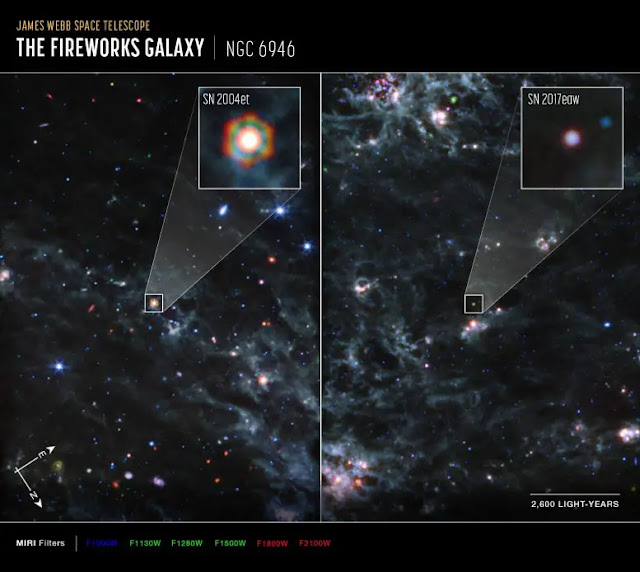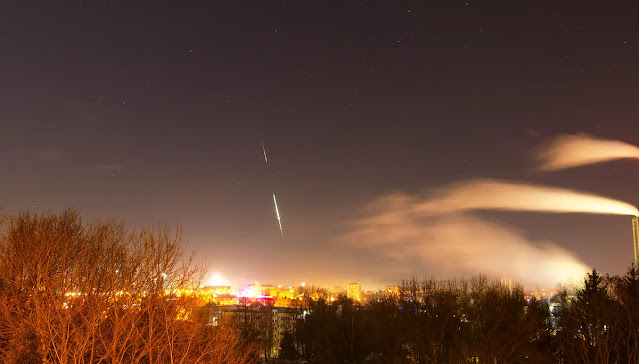A recent discovery shows that supernovae are probably the
sources of dust for early, young galaxies.
Some of the largest explosions of energy and light in the
cosmos are supernovae, the catastrophic deaths of stars. One supernova can
actually light brighter than a whole galaxy when it explodes.
It makes sense that NGC 6946, which is 22 million
light-years from Earth, is known as the Fireworks Galaxy. Nearly a dozen
supernovae have been seen blazing in the arms of this galaxy in the last
century.
This includes the supernovae 2004et and 2017eaw, which are
now being investigated by scientists using the MIRI (Mid-Infrared Instrument)
on the James Webb Space Telescope.Surprisingly, MIRI discovered substantial
amounts of dust in the ejecta of each of these objects. The mass discovered by
researchers lends credence to the idea that supernovae were crucial in feeding
the early universe with dust.
Dust Reservoirs Found by Webb Space Telescope in Two
Supernovae
The source of dust in early galaxies has been confirmed by
researchers using NASA’s James Webb Space Telescope. Large amounts of dust have
been found in the ejecta of both Supernova 2004et (SN 2004et) and Supernova
2017eaw (SN 2017eaw), two Type II supernovae that have been observed. The mass
discovered by researchers lends credence to the idea that supernovae were
crucial in feeding the early universe with dust.
The Galactic Building Block: Dust
Planets in particular are made of dust, which is a component
of many objects in our universe. As dead star dust travels across space, it
carries vital components that aid in the formation of new stars and planets.
Astronomers have been perplexed about the origin of such dust for many years.
Supernovae may be a significant source of cosmic dust because, after the dying
star explodes, the gas left behind expands and cools, producing dust.
According to lead author Melissa Shahbandeh of Johns Hopkins
University and the Space Telescope Science Institute in Baltimore, Maryland,
“direct evidence of this phenomenon has been scarce up to this point, with
our capabilities only allowing us to study the dust population in one
relatively nearby supernova to date – Supernova 1987A, 170,000 light-years away
from Earth.” “Only mid-infrared wavelengths are capable of detecting
dust when the gas cools down enough to form it, provided your sensitivity is
high enough.”
This combination of wavelength coverage and exceptional
sensitivity is only possible with Webb’s MIRI (Mid-Infrared Instrument) for
supernovae farther out than SN 1987A, such as SN 2004et and SN 2017eaw, both in
NGC 6946 (see image above), roughly 22 million light-years away.
Important Findings and Implications
Since the Atacama Large Millimeter/submillimeter Array
(ALMA) telescope discovered newly generated dust in SN 1987A over ten years
ago, the Webb findings represent the first significant advancement in the study
of dust creation from supernovae.
Not only was dust found throughout their investigation, but
also at this early point in the supernova’s life, and in such large quantities.
The researchers found more than 5,000 Earth masses of dust in SN 2004et.
“When you look at the calculation of how much dust
we’re seeing in SN 2004et especially, it rivals the measurements in SN 1987A,
and it’s only a fraction of the age,” continued program lead Ori Fox of
the Space Telescope Science Institute. “Since SN 1987A, the highest dust
mass has been detected in supernovae,”
Astronomers have discovered that newborn, far-off galaxies
are drenched in dust, yet these galaxies are too young to have been replenished
with dust over time by intermediate-mass stars like the Sun. To produce that
much dust, more massive, short-lived stars may have perished sooner and in
greater quantities.
Future Studies and Emerging Issues
Astronomers have established that supernovae generate dust,
but it is still unknown how much of that dust will endure the internal shocks
that will reverberate in the wake of the explosion. Supernovae are key dust
producers after all, as evidenced by the presence of this much dust at this
point in the lives of SN 2004et and SN 2017eaw. This shows that dust can
survive the shockwave.
The current mass estimates may only be the top of the
iceberg, according to researchers. While Webb has made it possible to measure
particles cooler than ever before, the outermost layers of dust may still be
obscuring the presence of undetected, colder dust that radiates even further
across the electromagnetic spectrum.
The new discoveries are only a first indication of newfound
research capabilities into supernovae and their dust creation using Webb, and
what that can reveal about the stars from which they originated, the
researchers noted.
There is rising interest in discovering what the dust’s
implications for the star’s core are, according to Fox. “After considering
these specific results, I believe our colleagues will be considering creative
approaches to working with these dusty supernovae in the future.”
The first two of the program’s five aims are SN 2004et and
SN 2017eaw. Webb General Observer software 2666 was used to complete the
observations. On July 5, the article was published in the Royal Astronomical
Society’s Monthly Notices.





